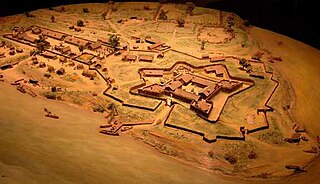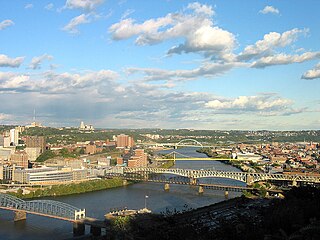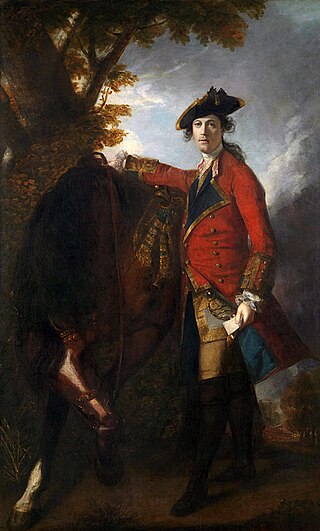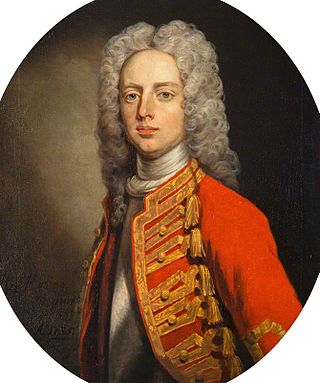
Fort Duquesne was a fort established by the French in 1754, at the confluence of the Allegheny and Monongahela rivers. It was later taken over by the British, and later the Americans, and developed as Pittsburgh in the U.S. state of Pennsylvania. Fort Duquesne was destroyed by the French before its British conquest during the Seven Years' War, known as the French and Indian War on the North American front. The British replaced it, building Fort Pitt between 1759 and 1761. The site of both forts is now occupied by Point State Park, where the outlines of the two forts have been laid in brick.

Fort Prince George was an uncompleted fort on what is now the site of Pittsburgh, at the confluence of the Allegheny and Monongahela Rivers in Allegheny County, Pennsylvania. The site was originally a trading post established by Ohio Company trader William Trent in the 1740s. Construction of Fort Prince George, named for the crown prince and later King George III), was begun in January 1754 by 41 Virginians. The plan to occupy the strategic forks was formed by Virginia Lieutenant Governor Robert Dinwiddie, on the advice of Lieutenant Colonel George Washington, whom Dinwiddie had sent on a mission to warn French commanders they were on English territory in late 1753, and had made a military assessment of the site. Captain Trent commanded the force constructing the fort, but his men were captured by 1,000 French soldiers and Indians led by Claude-Pierre Pécaudy de Contrecœur. At the time of the French arrival, Trent was at Wills Creek for a conference, while his second-in-command, Lieutenant John Fraser, was at his own plantation at Turtle Creek on the Mononghela River. Ensign Edward Ward was left to surrender the fort on April 18, 1754. The French attack was the hostile act of the war, and it led to George Washington's own surprise attack at the Battle of Jumonville Glen.

Braddock is a borough located in the eastern suburbs of Pittsburgh in Allegheny County, Pennsylvania, United States, 10 miles (16 km) upstream from the mouth of the Monongahela River. The population was 1,721 as of the 2020 census, a 91.8% decline since its peak of 20,879 in 1920.

North Braddock is a borough in Allegheny County, Pennsylvania, United States. North Braddock was organized from a part of Braddock Township in 1897. The borough prides itself in being the "Birth Place of Steel" as the home of Andrew Carnegie's Edgar Thomson Steel Works that opened in 1875. North Braddock is a suburb 11 miles (18 km) east of Pittsburgh with a 15-minute travel time to the city. The borough is located in the valley along the Monongahela River, and is made up of three jurisdictional voting wards.

Major-General Edward Braddock was a British officer and commander-in-chief for the Thirteen Colonies during the start of the French and Indian War (1754–1763), the North American front of what is known in Europe and Canada as the Seven Years' War (1756–1763). He is generally best remembered for his command of a disastrous expedition against the French-occupied Ohio River Valley in 1755; he was killed in the effort.

The Monongahela River, sometimes referred to locally as the Mon, is a 130-mile-long (210 km) river on the Allegheny Plateau in north-central West Virginia and Southwestern Pennsylvania. The river flows from the confluence of its west and east forks in north-central West Virginia northeasterly into southwestern Pennsylvania, then northerly to Pittsburgh and its confluence with the Allegheny River to form the Ohio River. The river includes a series of locks and dams that makes it navigable.

The Braddock expedition, also called Braddock's campaign or Braddock's Defeat, was a British military expedition which attempted to capture Fort Duquesne from the French in the summer of 1755, during the French and Indian War of 1754 to 1763. The British troops suffered defeat at the Battle of the Monongahela on July 9, 1755, and the survivors retreated. The expedition takes its name from General Edward Braddock (1695–1755), who led the British forces and died in the effort. Braddock's defeat was a major setback for the British in the early stages of the war with France; John Mack Faragher characterises it as one of the most disastrous defeats for the British in the 18th century.

The Battle of the Monongahela took place on July 9, 1755, at the beginning of the French and Indian War at Braddock's Field in present-day Braddock, Pennsylvania, 10 miles (16 km) east of Pittsburgh. A British force under General Edward Braddock, moving to take Fort Duquesne, was defeated by a force of French and Canadian troops under Captain Daniel Liénard de Beaujeu with its American Indian allies.

Fort Necessity National Battlefield is a National Battlefield in Fayette County, Pennsylvania, United States, which preserves the site of the Battle of Fort Necessity. The battle, which took place on July 3, 1754, was an early battle of the French and Indian War, and resulted in the surrender of British colonial forces under Colonel George Washington, to the French and Indians, under Louis Coulon de Villiers.

The Braddock Road was a military road built in 1755 in what was then British America and is now the United States. It was the first improved road to cross the barrier of the successive ridgelines of the Appalachian Mountains. It was constructed by troops of Virginia militia and British regulars commanded by General Edward Braddock of the Coldstream Guards, part of an expedition to conquer the Ohio Country from the French at the beginning of the French and Indian War, the North American portion of the Seven Years' War. George Washington was an aide-de-camp to General Braddock who accompanied the expedition. The expedition gave him his first field military experience along with other American military officers. A number of these men would profit from this experience during the Revolutionary War.

The Edgar Thomson Steel Works is a steel mill in the Pittsburgh area communities of Braddock and North Braddock, Pennsylvania, United States. It has been active since 1875. It is currently owned by U.S. Steel and is known as Mon Valley Works – Edgar Thomson Plant on its official website.

Turtle Creek is a 21.1-mile-long (34.0 km) tributary of the Monongahela River that is located in Allegheny and Westmoreland counties in the U.S. state of Pennsylvania. Situated at its juncture with the Monongahela is Braddock, Pennsylvania, where the Battle of the Monongahela was fought in 1755.

Daniel Hyacinthe Liénard de Beaujeu was a French officer during King George's War and the French and Indian War. He participated in the Battle of Grand Pre (1747). He also organized the force that attacked General Edward Braddock's army after it forded the Monongahela River. The event was later dubbed the Battle of the Monongahela. Beaujeu led his small force into the attack, where he was shot dead in the opening moments when the attack was launched on July 9, 1755. However, his adoption of Native American customs, such as wearing war paint and regalia, helped raise the morale and fighting tenacity of the warriors under his command.

Jean-Daniel Dumas was a French officer in the Seven Years' War. The French and Indians launched an attack on General Edward Braddock's column at the Battle of the Monongahela. Dumas and Charles Michel de Langlade took charge when their commanding officer, Daniel Liénard de Beaujeu, was shot dead in the opening moments of the battle.
Little Meadows is located at the foot of Meadow Mountain in western Maryland. It was a common stopping point for British troops during the French and Indian War and was frequented by George Washington.

The Forbes Expedition was a British military expedition to capture Fort Duquesne, led by Brigadier-General John Forbes in 1758, during the French and Indian War. While advancing to the fort, the expedition built the now historic trail, the Forbes Road. The Treaty of Easton served to cause a loss of Native American support for the French, resulting in the French destroying the fort before the expedition could arrive on November 24.
John Fraser was a fur trader licensed by the Province of Pennsylvania for its western frontier, an interpreter with Native Americans, a gunsmith, a guide and lieutenant in the British army, and a land speculator. He served in several of England's expeditions against the French and their allies in the vicinity of Fort Duquesne and later Fort Pitt.
Braddock's Battlefield History Center is a small American museum and visitors center on the site of the Battle of the Monongahela of 9 July 1755.

Captain Robert Orme was a British Army officer who took part in the Battle of the Monongahela on 9 July 1755 at the beginning of the French and Indian War, during which he was injured. He served with the young George Washington, with whom he became friends, and soon after his return to England in 1755 was painted by Joshua Reynolds.

Sir Peter Halkett, 2nd Baronet was a Scottish baronet who served in the British army and was Member of Parliament for Stirling Burghs from 1734 to 1741.


















